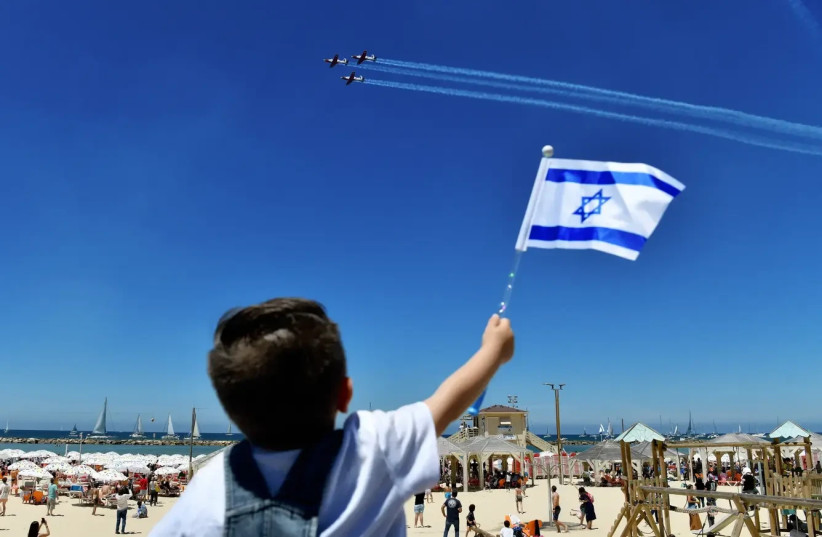Rabbi Samson Raphael Hirsch, the great figure of modern Orthodoxy in Germany, once wrote, “The Hebrew calendar is Judaism’s catechism.” The religious holidays communicate – in simple and popular ways – the fundamental values and practices of the Jewish religion. Observing them is a high marker of Jewish identity and religious living. Since 1948, the Knesset of Israel has turned two of the greatest events of Jewish history, the Holocaust and the creation of the state of Israel, into holy days on the Hebrew calendar. A hundred years from now, it will be clear that this week, anchored between Holocaust Remembrance Day and Independence Day, is the most powerful period of the Jewish calendar. That outcome depends on this generation grasping the new revelation in these two events and joining in embedding them in our culture and lives.
To start from the beginning: the core message of Judaism is redemption (geulah in Hebrew). This world – so full of evil, sickness, and death – will be repaired. All people will be freed and gain a homeland where they will live in dignity and equality. There is a covenant partnership (brit) between God and humanity to achieve this goal together.
The Jewish people, through living its Torah covenant, are teachers of this vision, pacesetters in creating a model society, and a role model for all people (or goyim) who seek to repair the world.
This message is conveyed by the story of the Exodus, in which the Hebrew slaves were liberated and eventually won a homeland. The Exodus story is in the calendar through the Shabbat holy day and in the reenactment of the Exodus during the holiday of Passover. The journey to the homeland is told and reenacted in the holiday of Sukkot.
Other redemptions along the historical journey of the Jews toward the final redemption of the whole world are also celebrated. Jews winning independence from the Greek empire was added to the calendar as the holiday of Hanukkah. Jews in the Diaspora fought off attempted genocide, and this story was added to the calendar as the Purim holiday.
Events of great destruction challenge the teaching of a final redemption. The Destruction of the First Temple and of the Second Temple and the long exile that followed struck a harsh blow at the credibility and livability of Judaism. The religion could not go on without acknowledging the tragedy and developing new rituals such as extended prayers to replace the lost sacrifices.
Also, mourning rituals (such as fasts and breaking a glass at wedding ceremonies) were added. Rituals and songs dedicated to remembering the homeland were greatly expanded. The fast day of Tisha Be’av (and three other mourning days) was added to the calendar. Periods of sadness (such as three weeks before Tisha Be’av and semi-mourning during the Omer counting period between Passover and Shavuot) were inserted into the annual cycle.
IN THE 20th century, the greatest destruction in Jewish history, mass murder, and genocide in the Holocaust, was inflicted on Jewry. Six million Jews and countless communities and Jewish worlds were demolished. Belief in God and the credibility of the Jewish traditions were deeply shaken. The religion could not go on without acknowledging the devastating attack and developing rituals of memory, mourning, and going forward.
The revival of Jewish life through the creation of Israel
The most important development was the renewal of life and recreation of Jewish culture and religious ways in creating the state of Israel. Israel constituted the Exodus of our era. Its development restored the credibility of the Jewish teaching of redemption and the tradition’s promise that the power of love and life is stronger than death.
Both these events carry momentous religious weight. In continuity with the Jewish tradition, so these events were translated into holy days and added to the sacred calendar. The fact that the Knesset established these days (and not the Chief Rabbinate) has misled some people into not grasping that these days are as holy and full of meaning as are the inherited holidays.
In a masterstroke, the Knesset set Holocaust Remembrance Day and Independence Day only eight days apart. Independence Day occurs on the anniversary of the proclamation of the independence of the State of Israel. However, Holocaust Remembrance Day is not the anniversary of any special event in the Holocaust. Why then is it located a week before Independence Day?
The original impetus for the day came from the partisans and ghetto fighters who survived and came to Israel after World War II. They wanted Holocaust Remembrance Day to be marked on the anniversary of the Warsaw Ghetto uprising, the high point of Jewish armed resistance. However, that actual date was April 19, 1943 – the eve, i.e. first night of Passover. The Nazis wanted to destroy the last Jew on the greatest holiday of redemption, Passover. Thereby, they thought to destroy the Jewish religion as well as the people.
LUCKILY, THIS proposed date for Holocaust Remembrance Day was rejected. To schedule it on Passover was to override the holiday of Passover as if the message of redemption was defeated by the Shoah. Furthermore, the date implicitly honored only the handful of Jews who were able to obtain arms and heroically fight the Nazis. It would have implicitly put down the millions of Jews whose bravery was expressed in staying Jewish, in holding families together, in living with dignity and kindness in the face of crushing persecution and murderous terror.
Holocaust Remembrance Day was delayed out of a political give and take. The mourning day was scheduled six days after Passover ended. There were two great gains in the chosen date. One is that Holocaust Remembrance Day honors the memory not just of the fighters but of all the six million Jewish martyrs who were killed because they were Jews. The other is that Holocaust Remembrance Day occurs close to the celebration of Israel, the great redemption of our time.
The Shoah is the clearest proof of the necessity of Jewish power and the indispensability of Jewish sovereignty to assure a homeland and haven for all Jews in the world. And Israel’s existence is the strongest proof that the Jewish covenant is still in full force and not defeated by the Holocaust. Israel proves that the promise of redemption for all people is unbroken. Despite all the opposition and the tragic events of the past year, Israel continues to develop and exemplify the Jewish people’s model for the world.
These two days symbolize the greatest assault of death and evil on life and the greatest outburst of life and renewal ever. They duel with each other – and reinforce each other – with unparalleled force. They have become the new heart of the Jewish calendar and religion.
The writer is an oleh, an activist and public intellectual in America, and author of The Triumph of Life: A Narrative Theology of Jews and Judaism (Jewish Publication Society, forthcoming).

